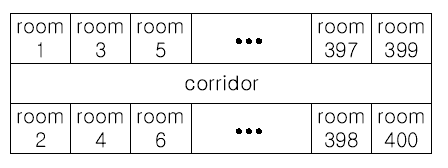- 一、基础数据结构——2.队列——3.双端队列和单调队列2
鸥梨菌Honevid
Algorithm数据结构
参考资料:《算法竞赛》,罗勇军郭卫斌著本博客作为阅读本书的学习笔记,仅供交流学习。建议关注罗勇军老师博客3.单调队列与最大子序和问题不限制子序列长度问题——贪心法或动态规划HDOJ1003MAXSUMMaxSumTimeLimit:2000/1000MS(Java/Others)MemoryLimit:65536/32768K(Java/Others)ProblemDescriptionGiven
- hdoj 2035 幂取余
Buffalooo
ProblemDescription求A^B的最后三位数表示的整数。说明:A^B的含义是“A的B次方”Input输入数据包含多个测试实例,每个实例占一行,由两个正整数A和B组成(1intmain(){intn,m;intans;inti;while(~scanf("%d%d",&n,&m)&&n&&m){ans=1;for(i=1;i<=m;i++){ans=(ans*n)%1000;}ans=a
- 2018-07-21-完全背包
termanary
题目:HDOJ-4508参考:1核心代码:for(i=0;i=b[i])p[j]=p[j]>p[j-b[i]]+a[i]?p[j]:p[j-b[i]]+a[i];}}
- 2018-07-21-数列
termanary
题目:HDOJ-1001HDOJ-2058HDOJ-2576参考:1假设x=sn则sn-sn-1=n(n+1)/2;s1=1;求sn的通项公式通过累加法之后化简可求得公式为Sn=n(n+1)(n+2)/6;对sn求余我们可以分成2部分即n(n+1)和(n+2)注意本题中要保证n(n+1)(n+2)能被6整除因为sn一定是个整数所以求余的时候要这样求余s1=(n(n+1))%(200905246);
- 深度优先搜索DFS与记忆化搜索
猴勒
算法算法深度优先
深度优先搜索(DFS)求连通块HDOJ-1241OilDeposits【题目】石油勘探公司把油田分成许多的大格,每个大格又分为许多小格,然后分析各个小格是否有石油矿藏。有矿藏的小格(用@表示)称为容器.如果2个容器相连(横、竖、斜),则它们是同一矿区的不同部分。输入各大格的矿藏分布(无矿藏用*表示),输出其中有多少个不同的矿区。#includeusingnamespacestd;charg[105
- HDOJ-2032
process21
杨辉三角ProblemDescription还记得中学时候学过的杨辉三角吗?具体的定义这里不再描述,你可以参考以下的图形:11112113311464115101051Input输入数据包含多个测试实例,每个测试实例的输入只包含一个正整数n(1<=n<=30),表示将要输出的杨辉三角的层数。Output对应于每一个输入,请输出相应层数的杨辉三角,每一层的整数之间用一个空格隔开,每一个杨辉三角后面加
- hdoj 2036 求多边形面积
Buffalooo
题目在这里:2036改革春风吹这题的目的就是求多边形的面积,求多边形的面积是通过将多边形分割成多个三角形,然后求多个三角形的面积和,就能得到多边形的面积。而求三角形的面积S=a*b由于题目是逆时针给的坐标,所以用向量求得的结果就是正数,如果是顺时针的话,求得的结果就是负数。如图是将左边转换为行列式后,行列式的运算:2036运算.jpg然后我们将所要求得多边形分割,如图所示2036分割.jpg那么如
- 2018-07-14-奇偶剪枝
termanary
题目:Problem-1010刚开始超时,网上查了一下,了解到了奇偶剪枝。改了一下,WA了一天,最后,看到:HDOJ1010HDU1010TempteroftheBoneACM1010INHDU-MiYu-博客园感谢提醒。原来用的是gets,scanf("%s"),getchar,scanf("%c"),都没有通过,最后用scanf("%c")和cin通过了。不过,我还有一点想不明白的是,效率应该
- ACM大学生程序设计竞赛在线题库最新精选题解(赵端阳)解析
长门yuki
本科acm算法acm竞赛
在线OJ题库部分解析测试网站主要为书中ZOJ,HDOJ。如果你准备入门acm,那以下题目顺序循序渐进,很适合各个阶段新手刷题。非常感谢本书作者和编审人员,后悔没有早点看到此书,相见恨晚!在此推荐一波希望更多像我一样的小白能从中受益受益。章节(完结)前言第1章基础编程技巧题第2章模拟编程技巧题第3章字符串处理技巧题(缺)第4章大整数运算技巧题第5章基本数据结构题第6章搜索算法题第7章动态规划算法题第
- 航电HDOJ2032 杨辉三角
Jccober
没事航电水水题目c语言算法杭电OJ
自己AC后又结合了网上一些好的思路重写了一边,废话少说上代码:#includeintmain(){inta[100][100];intn;for(inti=0;i<30;i++){a[i][0]=1;//第一列全赋为1a[i][i]=1;//每一行最后一个数为1for(intj=1;j<=i-1;j++){a[i][j]=a[i-1][j]+a[i-1][j-1];//根据杨辉三角规律处理}}wh
- 并查集与最小生成树
猴勒
图论算法
并查集HDOJ-1232畅通工程题目:省政府“畅通工程”的目标是使全省任何两个城镇间都可以实现交通,输入现有城镇道路统计表(表中列出了每条道路直接连通的城镇),求最少还需要建设的道路数量。(城镇从1到N编号)思路:将每组互相连通的城市视为一个不相交集合,不与其他城市连通的城市也视为一个集合。“使任何两个城镇间都可以实现交通”即将所有集合合并为一个集合。题目每行输入,定义该行的两个元素属于同一个集合
- 贪心算法经典习题7道
猴勒
贪心算法算法
HDOJ-1257最少拦截系统【题目】有一种带缺陷的导弹拦截系统,它的第一发炮弹能够到达任意的高度,之后每一发炮弹都不能超过前一发的高度。现给出导弹依次飞来的高度,计算一下最少需要多少套拦截系统。【思路】对每个炮弹进行处理:当前高度低于或等于其中一些系统:选择这些系统中高度最低的,该系统高度=当前高度当前高度高于所有系统:系统数+1,该系统高度=当前高度#include#defineINF3000
- 取石子问题 java,HDOJ 1527 取石子游戏(威佐夫博奕)
aniKuso
取石子问题java
取石子游戏TimeLimit:2000/1000MS(Java/Others)MemoryLimit:65536/32768K(Java/Others)TotalSubmission(s):7095AcceptedSubmission(s):3884ProblemDescription有两堆石子,数量任意,可以不同。游戏开始由两个人轮流取石子。游戏规定,每次有两种不同的取法,一是可以在任意的一堆中
- SUM PROBLEM
bbmessi
Hey,welcometoHDOJ(HangzhouDianziUniversityOnlineJudge).Inthisproblem,yourtaskistocalculateSUM(n)=1+2+3+...+n.InputTheinputwillconsistofaseriesofintegersn,oneintegerperline.OutputForeachcase,outputSUM(
- HDOJ2006平方和与立方和
대휘kiyo
HDOJ修炼
#include#include#includeusingnamespacestd;intmain(){inta,b,t,ou=0,ji=0;while(scanf("%d%d",&a,&b)!=EOF){ou=0;ji=0;//错误的地方,忽略的情况,但是连续整数不就是默认ab){t=a;a=b;b=t;}*/for(inti=a;i<=b;i++){if(i%2==0){ou+=pow(i,2
- hdoj-2037
天高地远_3764
链接:http://acm.hdu.edu.cn/showproblem.php?pid=2037今年暑假不ACProblemDescription“今年暑假不AC?”“是的。”“那你干什么呢?”“看世界杯呀,笨蛋!”“@#$%^&*%...”确实如此,世界杯来了,球迷的节日也来了,估计很多ACMer也会抛开电脑,奔向电视了。作为球迷,一定想看尽量多的完整的比赛,当然,作为新时代的好青年,你一定还
- HDOJ 十天刷题及答案 c++
宇宙第一甜心
HDOJ
HDOJ10天刷题顺序每天四五道(1.1代表第一天第一道),从易到难分享一下我的结果,都AC了,欢迎提意见哦~文章目录1.1.HDOJ10001.2.HDOJ10891.3.HDOJ10961.4.HDOJ10011.5.HDOJ20002.1HDOJ20012.2HDOJ20022.3HDOJ2003绝对值2.4HDOJ2004成绩转换2.5HDOJ20053.1HDOJ20103.2HDOJ2
- hdoj4741 求空间中不平行的两条直线的最短距离及最短线段与两直线的交点
竹舞清风_忆
竞赛计算几何acm模板
SaveLabmanNo.004TimeLimit:2000/1000MS(Java/Others)MemoryLimit:32768/32768K(Java/Others)TotalSubmission(s):2115AcceptedSubmission(s):711ProblemDescriptionDuetothepreeminentresearchconductedbyDr.Kyouma,
- 01背包——HDOJ2602拾骨者
奋起的熊猫
【算法】背包01背包
问题陈述:Manyyearsago,inTeddy’shometowntherewasamanwhowascalled“BoneCollector”.Thismanliketocollectvariesofbones,suchasdog’s,cow’s,alsohewenttothegrave…ThebonecollectorhadabigbagwithavolumeofV,andalonghis
- HDOJ题目分类
ao350322
c/c++数据结构与算法人工智能
1001整数求和水题1002C语言实验题——两个数比较水题10031、2、3、4、5...简单题1004渊子赛马排序+贪心的方法归并1005HeroInMaze广度搜索1006Redraiment猜想数论:容斥定理1007童年生活二三事递推题1008University简单hash1009目标柏林简单模拟题1010Rails模拟题(堆栈)1011BoxofBricks简单题1012IMMEDIAT
- A - 比赛难度 HDU - 4546
i-Curve
T数据结构
最近,小明出了一些ACM编程题,决定在HDOJ举行一场公开赛。假设题目的数量一共是n道,这些题目的难度被评级为一个不超过1000的非负整数,并且一场比赛至少需要一个题,而这场比赛的难度,就是所有题目的难度之和,同时,我们认为一场比赛与本场题目的顺序无关,而且题目也不会重复。显而易见,很容易得到如下信息:假设比赛只用1个题目,有n种方案;假设比赛使用2个题目,有(n-1)n/2种方案;假设比赛使用3
- HDU - 4546 比赛难度(Java & JS & Python)
伏城之外
算法与数据结构算法HDU-4546JavaJavaScriptPython
题目来源Problem-4546(hdu.edu.cn)题目描述最近,小明出了一些ACM编程题,决定在HDOJ举行一场公开赛。假设题目的数量一共是n道,这些题目的难度被评级为一个不超过1000的非负整数,并且一场比赛至少需要一个题,而这场比赛的难度,就是所有题目的难度之和,同时,我们认为一场比赛与本场题目的顺序无关,而且题目也不会重复。显而易见,很容易得到如下信息:假设比赛只用1个题目,有n种方案
- ACM2.3
九九询
A+BAgain----hdu-2057ProblemDescriptionTheremustbemanyA+BproblemsinourHDOJ,nowanewoneiscoming.Giveyoutwohexadecimalintegers,yourtaskistocalculatethesumofthem,andprintitinhexadecimaltoo.Easy?ACit!InputT
- 2018-07-01-HDOJ-2662-coin
termanary
学习自:【hdu-2662Coin】-ismdeep-博客园题目大意:任意两个质数,存在一个数,大于这个数的所有数都可以用这两个质数的次叠加表示。原证明:设所求为n,那么n+a、n+b可以用a、b线性表出,而n不可。所以n+a=x1*a+y1*b,n+b=x2*a+y2*b所以n=(x1-1)*a+y1*bn=x2*a+(y2-1)*b因为n不能被线性表出,所以x1=0,y2=0所以n+a=y1*
- HDOJ入门刷题记录
Lifegoeson.
刷题记录hdojhdoj刷题
菜鸟的刷题记录第一阶段:1000、1089—1096、10011000:A+BProblem#includeusingnamespacestd;intmain(void){inta,b;while(scanf("%d%d",&a,&b)!=EOF)coutusingnamespacestd;intmain(void){inta,b;while(scanf("%d%d",&a,&b)==2)cout
- hdoj 2022 选主角
Buffalooo
ProblemDescriptionpotato老师虽然很喜欢教书,但是迫于生活压力,不得不想办法在业余时间挣点外快以养家糊口。“做什么比较挣钱呢?筛沙子没力气,看大门又不够帅...”potato老师很是无奈。“张艺谋比你还难看,现在多有钱呀,听说还要导演奥运开幕式呢!你为什么不去娱乐圈发展呢?”lwg在一旁出主意。嗯,也是,为了生存,就委屈点到娱乐圈混混吧,马上就拍一部激光电影《杭电记忆——回来
- hdoj5806 NanoApe Loves Sequence Ⅱ
科学旅行者
题目:ProblemDescriptionNanoApe,theRetiredDog,hasreturnedbacktoprepareforfortheNationalHigherEducationEntranceExamination!Inmathclass,NanoApepickedupsequencesonceagain.Hewrotedownasequencewithnnumbersand
- OJ奇淫巧计汇总(c++版)
Explosion_M
刷题技巧OJ技巧
刷题时遇到的各种奇淫巧计(我认为的)本文章仅记录本菜鸟刷题时被教育所收获的经验长期更新通用篇PAT篇HDOJ篇通用篇一行多输出要求时,要求每个输出之间有一个空格,同时最后一个输出之后没有空格//这种情况普遍出现在循环输出时//以for循环为例for(inti=0;i>example){...}//这种写法在自己的ide中是不起作用的,应为它只有在读取到EOF时才会判断为false//但是OJ系统就
- 整数的尾数(HDOJ2099)
劳斯鸡
HDOJ2099题目的原意:设置好两个整数A、B,再设置一个I(0I<100),求出当的余数为零时的所有I值。思路:1.建立一个循环,利用公式(a*100+i)%b==0,将I由0到100的条件下都判断一遍,筛选出符合的数字并赋值给一个设定好的整形数组g[100]。2.再建立一个循环,分别输出每一个值。这里要注意同组数据之间留空格,最后一个数据不留空格并换行。在这里我设置里一个变量flag,初值为
- hdoj 2034 人见人爱A-B
Buffalooo
题目:人见人爱A-B这题的要求是,输入两个集合A、B,然后输出两个集合A-B。题目的要求非常简单,但是要注意的一点就是要先给集合A进行排序,因为题目要求从小到大输出答案。第二个要注意的是输出的格式,题目要求输出的每个元素后面要跟一个空格。我的思路就是要让B集合中的每个数跟A集合进行对比。定义两个整形变量flag=0和num=0。flag是用来判断B中是否有元素与A中的元素相同。而num是记录一共有
- jsonp 常用util方法
hw1287789687
jsonpjsonp常用方法jsonp callback
jsonp 常用java方法
(1)以jsonp的形式返回:函数名(json字符串)
/***
* 用于jsonp调用
* @param map : 用于构造json数据
* @param callback : 回调的javascript方法名
* @param filters : <code>SimpleBeanPropertyFilter theFilt
- 多线程场景
alafqq
多线程
0
能不能简单描述一下你在java web开发中需要用到多线程编程的场景?0
对多线程有些了解,但是不太清楚具体的应用场景,能简单说一下你遇到的多线程编程的场景吗?
Java多线程
2012年11月23日 15:41 Young9007 Young9007
4
0 0 4
Comment添加评论关注(2)
3个答案 按时间排序 按投票排序
0
0
最典型的如:
1、
- Maven学习——修改Maven的本地仓库路径
Kai_Ge
maven
安装Maven后我们会在用户目录下发现.m2 文件夹。默认情况下,该文件夹下放置了Maven本地仓库.m2/repository。所有的Maven构件(artifact)都被存储到该仓库中,以方便重用。但是windows用户的操作系统都安装在C盘,把Maven仓库放到C盘是很危险的,为此我们需要修改Maven的本地仓库路径。
- placeholder的浏览器兼容
120153216
placeholder
【前言】
自从html5引入placeholder后,问题就来了,
不支持html5的浏览器也先有这样的效果,
各种兼容,之前考虑,今天测试人员逮住不放,
想了个解决办法,看样子还行,记录一下。
【原理】
不使用placeholder,而是模拟placeholder的效果,
大概就是用focus和focusout效果。
【代码】
<scrip
- debian_用iso文件创建本地apt源
2002wmj
Debian
1.将N个debian-506-amd64-DVD-N.iso存放于本地或其他媒介内,本例是放在本机/iso/目录下
2.创建N个挂载点目录
如下:
debian:~#mkdir –r /media/dvd1
debian:~#mkdir –r /media/dvd2
debian:~#mkdir –r /media/dvd3
….
debian:~#mkdir –r /media
- SQLSERVER耗时最长的SQL
357029540
SQL Server
对于DBA来说,经常要知道存储过程的某些信息:
1. 执行了多少次
2. 执行的执行计划如何
3. 执行的平均读写如何
4. 执行平均需要多少时间
列名 &
- com/genuitec/eclipse/j2eedt/core/J2EEProjectUtil
7454103
eclipse
今天eclipse突然报了com/genuitec/eclipse/j2eedt/core/J2EEProjectUtil 错误,并且工程文件打不开了,在网上找了一下资料,然后按照方法操作了一遍,好了,解决方法如下:
错误提示信息:
An error has occurred.See error log for more details.
Reason:
com/genuitec/
- 用正则删除文本中的html标签
adminjun
javahtml正则表达式去掉html标签
使用文本编辑器录入文章存入数据中的文本是HTML标签格式,由于业务需要对HTML标签进行去除只保留纯净的文本内容,于是乎Java实现自动过滤。
如下:
public static String Html2Text(String inputString) {
String htmlStr = inputString; // 含html标签的字符串
String textSt
- 嵌入式系统设计中常用总线和接口
aijuans
linux 基础
嵌入式系统设计中常用总线和接口
任何一个微处理器都要与一定数量的部件和外围设备连接,但如果将各部件和每一种外围设备都分别用一组线路与CPU直接连接,那么连线
- Java函数调用方式——按值传递
ayaoxinchao
java按值传递对象基础数据类型
Java使用按值传递的函数调用方式,这往往使我感到迷惑。因为在基础数据类型和对象的传递上,我就会纠结于到底是按值传递,还是按引用传递。其实经过学习,Java在任何地方,都一直发挥着按值传递的本色。
首先,让我们看一看基础数据类型是如何按值传递的。
public static void main(String[] args) {
int a = 2;
- ios音量线性下降
bewithme
ios音量
直接上代码吧
//second 几秒内下降为0
- (void)reduceVolume:(int)second {
KGVoicePlayer *player = [KGVoicePlayer defaultPlayer];
if (!_flag) {
_tempVolume = player.volume;
- 与其怨它不如爱它
bijian1013
选择理想职业规划
抱怨工作是年轻人的常态,但爱工作才是积极的心态,与其怨它不如爱它。
一般来说,在公司干了一两年后,不少年轻人容易产生怨言,除了具体的埋怨公司“扭门”,埋怨上司无能以外,也有许多人是因为根本不爱自已的那份工作,工作完全成了谋生的手段,跟自已的性格、专业、爱好都相差甚远。
- 一边时间不够用一边浪费时间
bingyingao
工作时间浪费
一方面感觉时间严重不够用,另一方面又在不停的浪费时间。
每一个周末,晚上熬夜看电影到凌晨一点,早上起不来一直睡到10点钟,10点钟起床,吃饭后玩手机到下午一点。
精神还是很差,下午像一直野鬼在城市里晃荡。
为何不尝试晚上10点钟就睡,早上7点就起,时间完全是一样的,把看电影的时间换到早上,精神好,气色好,一天好状态。
控制让自己周末早睡早起,你就成功了一半。
有多少个工作
- 【Scala八】Scala核心二:隐式转换
bit1129
scala
Implicits work like this: if you call a method on a Scala object, and the Scala compiler does not see a definition for that method in the class definition for that object, the compiler will try to con
- sudoku slover in Haskell (2)
bookjovi
haskellsudoku
继续精简haskell版的sudoku程序,稍微改了一下,这次用了8行,同时性能也提高了很多,对每个空格的所有解不是通过尝试算出来的,而是直接得出。
board = [0,3,4,1,7,0,5,0,0,
0,6,0,0,0,8,3,0,1,
7,0,0,3,0,0,0,0,6,
5,0,0,6,4,0,8,0,7,
- Java-Collections Framework学习与总结-HashSet和LinkedHashSet
BrokenDreams
linkedhashset
本篇总结一下两个常用的集合类HashSet和LinkedHashSet。
它们都实现了相同接口java.util.Set。Set表示一种元素无序且不可重复的集合;之前总结过的java.util.List表示一种元素可重复且有序
- 读《研磨设计模式》-代码笔记-备忘录模式-Memento
bylijinnan
java设计模式
声明: 本文只为方便我个人查阅和理解,详细的分析以及源代码请移步 原作者的博客http://chjavach.iteye.com/
import java.util.ArrayList;
import java.util.List;
/*
* 备忘录模式的功能是,在不破坏封装性的前提下,捕获一个对象的内部状态,并在对象之外保存这个状态,为以后的状态恢复作“备忘”
- 《RAW格式照片处理专业技法》笔记
cherishLC
PS
注意,这不是教程!仅记录楼主之前不太了解的
一、色彩(空间)管理
作者建议采用ProRGB(色域最广),但camera raw中设为ProRGB,而PS中则在ProRGB的基础上,将gamma值设为了1.8(更符合人眼)
注意:bridge、camera raw怎么设置显示、输出的颜色都是正确的(会读取文件内的颜色配置文件),但用PS输出jpg文件时,必须先用Edit->conv
- 使用 Git 下载 Spring 源码 编译 for Eclipse
crabdave
eclipse
使用 Git 下载 Spring 源码 编译 for Eclipse
1、安装gradle,下载 http://www.gradle.org/downloads
配置环境变量GRADLE_HOME,配置PATH %GRADLE_HOME%/bin,cmd,gradle -v
2、spring4 用jdk8 下载 https://jdk8.java.
- mysql连接拒绝问题
daizj
mysql登录权限
mysql中在其它机器连接mysql服务器时报错问题汇总
一、[running]
[email protected]:~$mysql -uroot -h 192.168.9.108 -p //带-p参数,在下一步进行密码输入
Enter password: //无字符串输入
ERROR 1045 (28000): Access
- Google Chrome 为何打压 H.264
dsjt
applehtml5chromeGoogle
Google 今天在 Chromium 官方博客宣布由于 H.264 编解码器并非开放标准,Chrome 将在几个月后正式停止对 H.264 视频解码的支持,全面采用开放的 WebM 和 Theora 格式。
Google 在博客上表示,自从 WebM 视频编解码器推出以后,在性能、厂商支持以及独立性方面已经取得了很大的进步,为了与 Chromium 现有支持的編解码器保持一致,Chrome
- yii 获取控制器名 和方法名
dcj3sjt126com
yiiframework
1. 获取控制器名
在控制器中获取控制器名: $name = $this->getId();
在视图中获取控制器名: $name = Yii::app()->controller->id;
2. 获取动作名
在控制器beforeAction()回调函数中获取动作名: $name =
- Android知识总结(二)
come_for_dream
android
明天要考试了,速速总结如下
1、Activity的启动模式
standard:每次调用Activity的时候都创建一个(可以有多个相同的实例,也允许多个相同Activity叠加。)
singleTop:可以有多个实例,但是不允许多个相同Activity叠加。即,如果Ac
- 高洛峰收徒第二期:寻找未来的“技术大牛” ——折腾一年,奖励20万元
gcq511120594
工作项目管理
高洛峰,兄弟连IT教育合伙人、猿代码创始人、PHP培训第一人、《细说PHP》作者、软件开发工程师、《IT峰播》主创人、PHP讲师的鼻祖!
首期现在的进程刚刚过半,徒弟们真的很棒,人品都没的说,团结互助,学习刻苦,工作认真积极,灵活上进。我几乎会把他们全部留下来,现在已有一多半安排了实际的工作,并取得了很好的成绩。等他们出徒之日,凭他们的能力一定能够拿到高薪,而且我还承诺过一个徒弟,当他拿到大学毕
- linux expect
heipark
expect
1. 创建、编辑文件go.sh
#!/usr/bin/expect
spawn sudo su admin
expect "*password*" { send "13456\r\n" }
interact
2. 设置权限
chmod u+x go.sh 3.
- Spring4.1新特性——静态资源处理增强
jinnianshilongnian
spring 4.1
目录
Spring4.1新特性——综述
Spring4.1新特性——Spring核心部分及其他
Spring4.1新特性——Spring缓存框架增强
Spring4.1新特性——异步调用和事件机制的异常处理
Spring4.1新特性——数据库集成测试脚本初始化
Spring4.1新特性——Spring MVC增强
Spring4.1新特性——页面自动化测试框架Spring MVC T
- idea ubuntuxia 乱码
liyonghui160com
1.首先需要在windows字体目录下或者其它地方找到simsun.ttf 这个 字体文件。
2.在ubuntu 下可以执行下面操作安装该字体:
sudo mkdir /usr/share/fonts/truetype/simsun
sudo cp simsun.ttf /usr/share/fonts/truetype/simsun
fc-cache -f -v
- 改良程序的11技巧
pda158
技巧
有很多理由都能说明为什么我们应该写出清晰、可读性好的程序。最重要的一点,程序你只写一次,但以后会无数次的阅读。当你第二天回头来看你的代码 时,你就要开始阅读它了。当你把代码拿给其他人看时,他必须阅读你的代码。因此,在编写时多花一点时间,你会在阅读它时节省大量的时间。
让我们看一些基本的编程技巧:
尽量保持方法简短
永远永远不要把同一个变量用于多个不同的
- 300个涵盖IT各方面的免费资源(下)——工作与学习篇
shoothao
创业免费资源学习课程远程工作
工作与生产效率:
A. 背景声音
Noisli:背景噪音与颜色生成器。
Noizio:环境声均衡器。
Defonic:世界上任何的声响都可混合成美丽的旋律。
Designers.mx:设计者为设计者所准备的播放列表。
Coffitivity:这里的声音就像咖啡馆里放的一样。
B. 避免注意力分散
Self Co
- 深入浅出RPC
uule
rpc
深入浅出RPC-浅出篇
深入浅出RPC-深入篇
RPC
Remote Procedure Call Protocol
远程过程调用协议
它是一种通过网络从远程计算机程序上请求服务,而不需要了解底层网络技术的协议。RPC协议假定某些传输协议的存在,如TCP或UDP,为通信程序之间携带信息数据。在OSI网络通信模型中,RPC跨越了传输层和应用层。RPC使得开发

